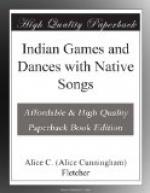Directions.—A clear space will be required large enough for all the dancers to move about in the final dance. Those who personate the Flowers should be hidden from view until the time when they are to respond to the call. In the properties enumerated above, mention is made only of scarfs. The picturesqueness of the dance would be enhanced if the dancers wore headdresses shaped somewhat like the flowers and made of appropriate colored paper; blue or lilac for the Violets, with a touch of yellow; deep pink or pale red for the Wild-roses, with a little yellow for the stamens; white with yellow for the Daisies. The twisted rope of green paper should be made over heavy twine, so as to be strong enough for the dancers to grasp in the final dance. All these decorative articles should be made in the camp.
The dancer who acts as the Caller should wear the green scarf loosely thrown about the head and body. If the voice of this dancer is not strong enough to be clearly heard by those who look on at a little distance, then two other persons should stand one at each side of the open space and sing with the dancer who is the Caller. These two extra singers should be wrapped in green scarfs and stand quietly as interested spectators while the dancer calls. Care should be taken to give the words of the songs with clearness and distinctness, so that every person within hearing distance can catch them easily.
THE DANCE
The scene opens with the one who is to call the Flowers standing in the center, looking about in different directions. Suddenly, as if the thought occurred to call for companions, the following song is begun:
Song No. 1
CALL TO THE FLOWERS
Hither come, come to me, flowers!
Wake from your
sleep.
Oh, hither come, hither come, flowers!
Hear me calling,
Wake from your sleep, O flowers!
Hark! some one
comes.
[Music]
With the song, movement begins. The steps taken should be gentle and gliding, the arms outstretched as in entreaty, the hands moved as in beckoning, not with one finger but all the fingers slowly bending toward the open palm. The dancer should think what the action means as she glides about the open space, and strive to carry out the picture of awakening the sleeping flowers, of bidding them to “come hither.” It is possible that more time may be required by some dancers to produce the picture than merely singing the song once through would give; in that case, that portion of the song having the words “Hear me calling, Wake from your sleep, O flowers!” can be repeated once or twice, to meet the requirements of the dancer. The last line, “Hark! some one comes!” should be given with dramatic action.
These words are the cue for those who are to represent the Violets to prepare to enter from different points on the right, and to make a soft, stirring sound before they come into view, singing the following song:




